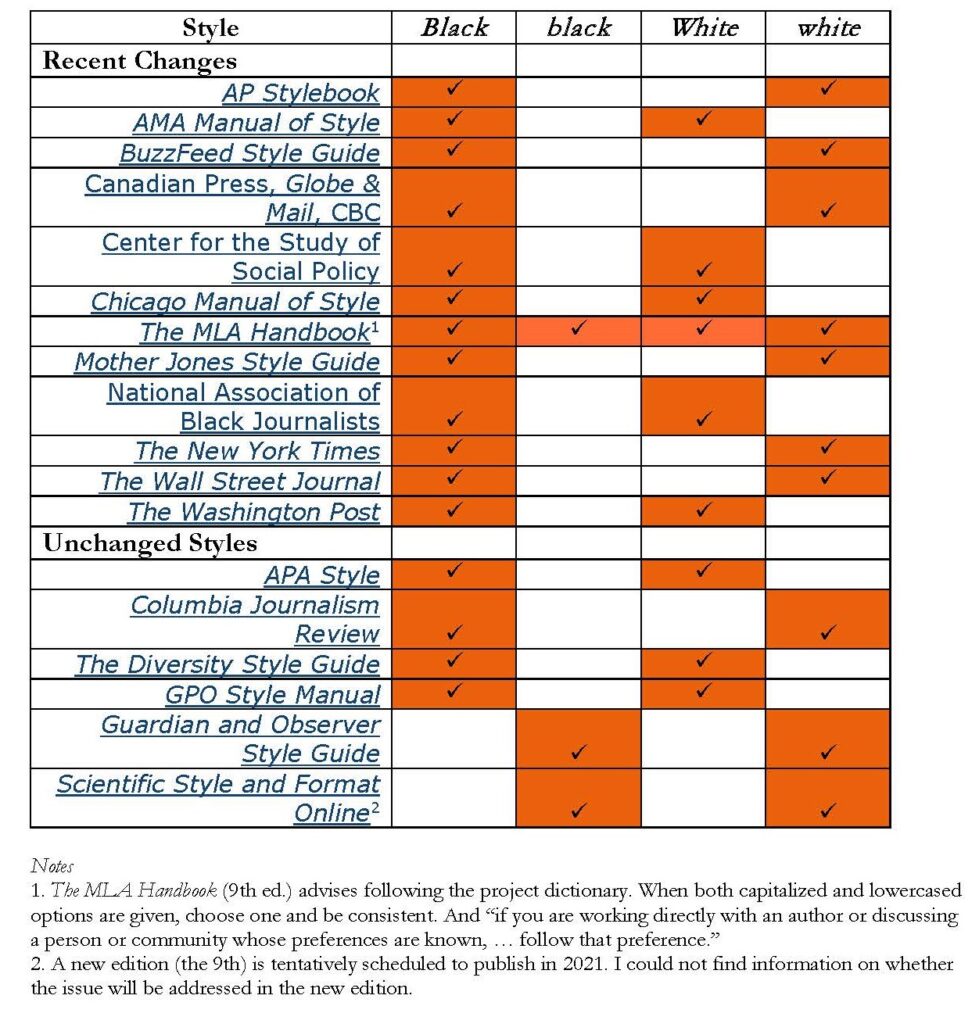Update: October 26, 2021
With the 9th edition (2021), MLA has updated its advice to the following: “When the dictionary gives both the capitalized and lowercased form as acceptable options—as many do for black and Black, for example—choose one and be consistent. If you are working directly with an author or discussing a person or community whose preferences are known, however, follow that preference” (p. 91). Updated as well is the current estimated publishing date for the Scientific Style and Format Online. The PDF and table have been updated below.
Original: August 3, 2020
Writers and editors of some forms of English are reviewing how to capitalize Black and White when they’re used to refer to race or skin color, thanks to recent events. In the last two months, several style guides and publishers have made changes, while others are reviewing the conversation and discussing policies. Style updates are coming out almost daily, and many organizations are looking to their editors for guidance.
To better serve my clients, I’ve done a deep dive into style guides, media outlets, and professional member organizations to see what their policies are.
The results are in the table below. I’ve sorted them by whether the style decision is recent or not. A change in capping either term put the organization in the “Recent Changes” category. So, for example, while the Associated Press is maintaining its style for lowercase white, because it updated its style for Black, I’ve listed it “Recent Changes.”
It’s also worth knowing which publications haven’t addressed the issue, in some cases because their style already reflects the current capping trend (Diversity, APA). Styles that don’t at least review their style should be urged to.
Data was originally collected July 20–31, 2020.
Capitalization Style for Black and White as Race Terms

Capping Black is becoming standard. Of the 17 organizations I looked at, 15 cap the term. For some, like APA and the Diversity Style Guide, it’s been standard for a while. Others have made the change only in the last few months.
Far fewer organizations (seven) now cap White and only two of them have been capping White for more than a few months. The two organizations reviewed that lowercase black also lowercase white. But many that have decided to cap Black have decided to keep White lowercase.
This is not a settled question. Language changes with use. As we change, so does language. And sometimes we just can’t make up our minds. The Canadian Style (not listed in the table) was last updated in 1997 and advises capping Black, but it notes that African American is gaining popularity in the US. Now we’re rethinking African American because not all Black Americans are from Africa or can trace their roots directly to Africa, so the term is inaccurate for them.
How to Make an Editorial Decision
It’s easy to follow a guide and not have to think about it—that’s what guides are for. So if yours is listed in the table, hooray!
What if you have to make the decision for your employer or clients? Start with the same concerns you make other writing-style decisions: by considering the audience, subject, writer, and publisher.
- What are the audience’s expectations?
- What’s the trend within the subject you’re editing?
- What message does the author want to send?
- What message does the publisher want to send?
These articles can help you weigh the issues:
- “Reasons for Lowercasing the Word ‘White’ in Your Writing: A Letter to an Author” by Kate Babbitt
- “If Black Is Up, Do We Capitalize White” by Mark Allen
- “The Case for Capitalizing the B in Black” by Kwame Anthony Appiah (The Atlantic)
- “The Associated Press Announced It Will Not Capitalize W in White” by Eliana Miller (Poynter)
- “Why We Confuse Race and Ethnicity: A Lexicographer’s Perspective” by Kory Stamper (Conscious Style Guide)
- “Whiteness,” Racial Equity Tools Glossary
- “About the Racial Equity Tools Glossary,” Racial Equity Tools Glossary
- “Why ‘White’ Should Be Capitalized, Too” by Nell Irvin Painter (The Washington Post)
Here’s a synopsis of common reasons to cap or lowercase White:
| Cap White | Lowercase white |
| It acknowledges that White is a political or cultural identity that’s invisible when lowercased, the “normal” which all other identities are measured against. | The White community doesn’t have a strong sense of a shared culture and history. |
| It’s capped by many Black organizations, such as the NABJ, which indicates how other communities view White people. | White people often identify with other ethnicities (e.g., Italian American, Irish American). |
| It encourages the White community to address hate and supremacist groups that cap it. | It distances the White community from hate and supremacist groups that cap it. |
The arguments point to the heart of the problem: As a rule, White Americans have not thought about themselves as a unique cultural group. There’s been little introspection into who we are, what we do, and how both of those things affect people who are not in power. It’s time we did so.
Writers and publishers can seek out editorial and cultural advice to make the best decisions for their content. Editors can follow the guides our clients and employers use. We can point out the most current arguments, focusing on those that are most relevant to the reader, content, author, and publisher.
I don’t think we’ll figure it out overnight, and that will be reflected by the different spelling choices organizations make. I think we’ll see the capitalization go back and forth while we White Americans figure out who we are.
We can only do our best. When we get it wrong, we should admit it and fix it. When the situation changes, we should change with it.
Just as our language does.
Many people offered suggestions on which resources to look at, especially those most important to their own work. Several did some research for me for those resources I didn’t have access to. In particular, I’d like to thank Rosemary Gretton, Karin Horler, Kate Kelly, Adrienne Montgomerie, Katharine O’Moore-Klopf, and Gael Spivak for their research help. Thanks also to Kate Babbitt and Mark Allen for their posts pointing to more resources.
Get writing advice straight in your inbox.
Sign up for Right Touch Editing’s emails!



I have been looking all over for an article like this. I write book reviews and nobody was able to clearly answer me when it came to capitalization. Thank you so much for an easy to read and utilize article.
You’re welcome! That was the frustration with my clients and many fellow editors. Changes are happening so quickly, it’s tough to keep up with them!
What’s the trend among book publishers? Most the articles I have seen on the subject concern newspapers, magazines, networks, and institutions. What about book publishers like Random House, Simon & Schuster, et al?
That’s a good question, Tom. Book publishers tend to follow one of the major style guides. Many follow the Chicago Manual of Style, listed in the chart. AMA is popular for medical texts, APA for social sciences (both listed in the chart). One thing to note, however, is that books have a much longer production time. Any changes to style made today won’t show up in books they’re applied to months if not longer. It’s just the nature of book publishing. I hope that helps!
If one is trying to make a statement, one should choose the capital/lower case difference that reflects it. If one is trying to be fair and equal, one should pick the same for both and stick to it. Why is this hard?
Thanks for your thoughts, Williann. I’d say it’s because not everyone is making the same statement and not everyone agrees what is fair and equal.
When referring to race, Black and White should be capitalized.
A) a black ball
B) a black bird
C) a black cat
D) a Black man
A) a white shirt
B) a white dove
C) a white mouse
D) a White woman
Thanks for your thoughts, Jay. Some of the resources listed in this post agree with you, while others don’t. It’s worth writers and editors thinking through this issue and coming to a decision that works best for their situation.
When the standard convention is to capitalise other groups of people, then they should be consistent and do so here. There may be circumstances where the person can be described as white or black, because they avoid the sun, or saw something frightening, e.g. she was white as a ghost, or, I knew when I saw him that he was the chimney sweep, because he was black, then the lower case is appropriate. When it is to identify the person’s unchanging ethnic background being of African or European descent, then the consistent thing to do would be to capitalise.
Thanks for your thoughts, Jerry. I agree that when white or black is being used other than as a race term, it would be lowercased. The issue is whether they should be capped when they’re used as race terms. As the chart shows, there isn’t universal agreement on whether skin color should be capped to indicate race or ethnicity. Capping the terms is certainly a legitimate style choice, however, as the chart also shows. Thanks for reading!
I find treating races differently I.e. Black v white can be startling when reading. Style guides should emphasize consistency rather than making political statements.
Not jarring the reader is definitely one consideration style guides address. I don’t think they’re engaging in politics by setting styles for race terms, though. It’s another way of considering the reader and their reaction to terms.